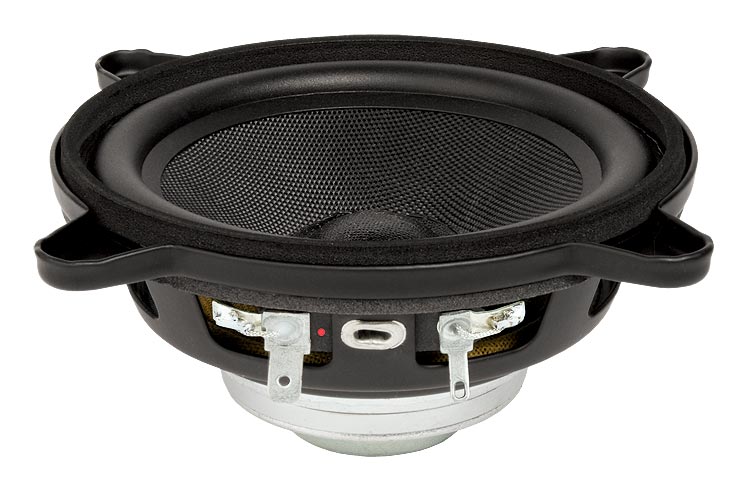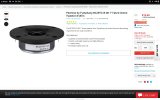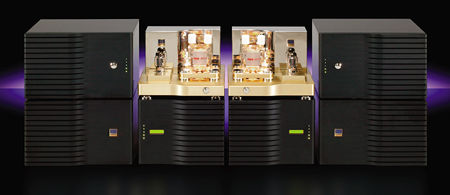OP
Kartingboy
Member
- Joined
- Jan 4, 2023
- Messages
- 27
- Likes
- 27
Tube amp circuits that have a relatively high output resistance will exhibit the most desirable (from a technically correct amp operation, ie no coloration) with a speaker that has a flat impedance response with not deep dips nor high peaks.
Such amps have a sound depending on the load.
Speaker designers can actually create a 'flatter impedance' response but costs money and for most amps will do nothing beneficial.
Tube amp designers can lower the output resistance of their amps by increasing open-loop gain and using overall feedback.
But that defeats the purpose of the 'good tube sound' these designers are after. That sound is load dependent.
It is not inherently to tube amps though but rather the design (mostly overall feedback).
Most people that buy tube amps do this on the merit of them (change the tonal signature) on their speakers in their room or based on the promise of 'best sound quality'.
Changing speakers or amps may result in more or less desirable sound (and contribute to the tube amp sound debate).
How much power one really needs depends on efficiency, room size, listening distance, desired maximum SPL.
For instance, when using a separate sub with a more powerful amp and high-pass on the low power amp for the mains can increase the maximum delivered SPL.
What's the output impedance?They measure such that, as I understand it, they can still be reactive to different loads.
source: https://www.stereophile.com/content/conrad-johnson-premier-twelve-monoblock-amplifier-measurementsThe Premier Twelve's output impedance measured 0.87 ohms at 20Hz and 1kHz, increasing to 1.09 ohms at 20kHz (into a 4 ohm load)—high enough to moderately affect the frequency response of the amplifier with a typical loudspeaker.
What's the output impedance?
I'm curious: How much - if at all - can higher power in a tube amp make up for any of that?
Power can not solve high output resistance and frequency non linearties.
What you ran into with lower power amps is 'soft clipping' of tube amps which is less objectionable but results in not nice sound lacking body/impact/quality.
More power means louder = more impressive and not as non-linear.
A different output power amplifier could well have a lower output R or wider frequency response or lower distortion.
The same design but with more power (not different tubes) will not change anything.
So if I've read that right, the frequency variations can still be there.
Good to hear!Hi
Finally the amp is arrived. It sounds terrific with my Indiana line speakers. With better speakers it must be incredible!
Very smooth and sweet sound and also fast I would say. And warm obviously.
Very happy with it.


So if I've read that right, the frequency variations can still be there, but if the lower power tube amps were running out of power, significantly higher power can help solve the "lack of impact" issue?
Anecdotally: My CJ amps certainly do not sound neutral. I sometimes borrow my friend's Bryston 4B3 - 300W into 8 ohms (and up to 500 into 4 ohms) per channel - and it sounds more precise in every way, especially in the bottom end. Though I find the tube amp (again presuming sonic differences) has an interesting psycho-acoustic effect. Like when I play one of my favourite soundtracks, Conan The Barbarian, which is an extra large orchestra playing balls-to-the-wall loud as hell, there are parts where lots of instruments are playing in the power region - low horns/woodwinds/strings - which can get a bit more muddy on the tube amp. The Bryston presents those difficult moments more clearly, I can hear what each section is doing. Yet I was surprised that the overall effect through my tube amps actually felt a bit more powerful and impactful, like it thickened up the sound for more force (possibly introducing some distortion that says to my ears 'sounds louder?'). The fact the Bryston was a much more powerful solid state amp might have suggested I'd percieve the presentation as more powerful, but that's not how it worked. (Maybe things would change if I turned up the sound even louder than I did - perhaps then I'd percieve the tube amp as wimping out at some point).
Evocative of the (magnificent, by the way) RCA "Refrigerator" enclosure for the iconic LC-1A coax.Good to hear!
Tell us more in the future about how it goes for you when you test different speakers together with your tube amplifier.
If you're trying to build something yourself and it's the first time you've done it, it probably makes sense to buy a speaker DIY kit.
Otherwise, with 15 watts I had tested, for example, these:
Mid:

4FE32 (8Ω) by FaitalPRO
FaitalPRO combined the latest R&D methods and technologies with the most advanced industrial automation techniques and all FaitalPRO drivers are made in Italy with the highest level of quality, consistency and durability.faitalpro.com
Tweeter:
View attachment 256707
Good sensitivity on them plus 8 Ohm (that your amp likes). Crossover maybe around 2.5-3.5 kHz.
Plus some reasonable bass element and crossover around 300-500 Hz. I had let a class d amp take care of the bass driver. In other words, a hybrid-powered three-way speaker.
Large baffle can be smart because it provides support for the elements (in the lower frequencies). Preferably with round baffle edges (for sensible FR for the higher frequencies).Shape of the speaker I'm thinking of that you can make is shaped like this 98dB sensitive (according to the manufacturer) speaker:
View attachment 256706
The frequency variations are certainly still there, and more power will not have any effect. Note, higher power tube amplifiers do tend to have lower output impedances, but that is a trend, not an absolute truth!So if I've read that right, the frequency variations can still be there, but if the lower power tube amps were running out of power, significantly higher power can help solve the "lack of impact" issue?

MattHooper,
Possibly there are multiple factors contributing to what you are hearing:
- Some IM distortion at play - you mentioned the busier passages become less clear
- Lower DF (higher output impedance) leading to less control of the woofers, so a perception of "more bass" or mid-range with more body, even though it is less precise
There are elements of these "colorations" that can be enjoyable.
The frequency variations are certainly still there, and more power will not have any effect. Note, higher power tube amplifiers do tend to have lower output impedances, but that is a trend, not an absolute truth!
They plot the resulting responses into various loads, each is plotted at different power to normalize, 1W into 8 Ohm, 2W into 4 Ohm, 4W into 2 Ohm....Conrad-Johnson Premier Twelve monoblock amplifier Measurements
Sidebar 3: Measurements Following its preconditioning test, the Conrad-Johnson Premier Twelve was hot—typical for a tube amplifier. The bias was found to be slightly off during the distortion measurements, was recalibrated, and the prior measurements were rechecked to ensure that the results had...www.stereophile.com
View attachment 256716
The power matters not one bit to the FR, just to the output.
Your perceived lack of impact I suggest is due to the most common source of sound differences and degradation in amplifiers; running out of power.
Your CJ Twelves are really decent for output impedance compared to other tube amps, around 1 Ohm.
Here is another CJ that doesn't do so well:
Output impedance is around 2 Ohms, FR variations double in magnitude compared to the CJ Twelve. To me this is marginal on most speakers, unacceptable on many with low impedance.Conrad-Johnson LP125M monoblock power amplifier Measurements
Sidebar 3: Measurementswww.stereophile.com
View attachment 256717
Or the Wavac SH-833, a hot mess which epitomizes part of this industry:
View attachment 256719
The Leben is on the high side of output impedance (2-3.5 Ohms) and will have surprising and unrealistic interactions with many speakers.
Leben CS300 integrated amplifier Measurements
Sidebar 3: Measurements To measure the Leben, I used Stereophile's loaner Audio Precision SYS2722 system (see www.ap.com and the January 2008 "As We See It").www.stereophile.com
Perhaps not today's design ideal. That in the form of how the speakers look nowadays. It is more narrow baffles that are the thing these days. But with that said, retro/vintage looks seem to be selling.Evocative of the (magnificent, by the way) RCA "Refrigerator" enclosure for the iconic LC-1A coax.

"Elvis approved!"

Yes. I think your hunches are supported!That's the type of stuff I was thinking. But I'm a putz when it comes to understanding electrical theory, so it's just poorly supported hunches on my part.
I think there are two things at play.Thanks for that detailed, informative reply!
Since I have your ear for a moment:
My CJs are currently driving my Thiel 2.7 speakers. The official specs are:
Bandwidth (–3dB) 35 Hz-20 kHz
Amplitude Response 35Hz-20 kHz ±2.5 dB
Phase Response Minimum ±10°
Sensitivity 87 [email protected] V-1m
Impedance 4 Ω (2.4 Ω minimum@160Hz) Recommended Power 100-400 watts
Size (w x d x h) 11 x 16.7 x 41 inches
I'm going to be putting my Joseph Audio Perspective speakers back in to my system soon. I just had them upgraded to the "Perspective2" version (which involved replacing with the newer SEAS drivers/updated crossover). Here's how Stereophile measured the Perspective original and 2 version:
Joseph Audio Perspective loudspeaker Perspective2 Graphene
John Atkinson reviewed the Joseph Audio Perspective2 in July 2019 (Vol.42 No.7):www.stereophile.com
As I understand it, the Joseph speakers are less sensitive, but present an easier load for an amplifier with a generally higher, more even impedance - the type of thing people with tube amps look for. So despite the lower sensitivity, should one expect there to be possibly less interaction/coloration between the CJ and the Joseph speakers vs the Thiels?
Yes. I think your hunches are supported!
I think there are two things at play.
One is the interaction with the output impedance of the amp. With the Theil and CJ 12, the minima in speaker impedance at 160Hz will cause the response to be similar to the 2-Ohm trace that Stereophile produced, i.e. a dip in response. As the speaker impedance rises with frequency, it will look more like the Simulated Speaker Load, or the 4Ohm. Net response more like what I drew in red, with HF rolloff details unclear to me (and likely inaudible to both of us!!!) This doesn't look bad, in fact in many rooms and speaker placements having slightly reduced midbass is going to be preferable, your mileage will vary!
View attachment 256741
I guess the second issue is the stability of an amp into low impedance. This is a more nuanced and complicated subject. My own unsupported hunch is the Thiel are moderately difficult to drive and has impedance where you start to find some otherwise 'good' amplifiers struggling, and this struggle is going to produce unwanted distortion and noise more than frequency response changes, with some amps shutting down or blowing fuses and devices. I would agree that the Perspective 2 are going to present a load that almost any amplifier will find stable, and the remaining question is do you have enough power to drive them to your preferred volume given the efficiency.
Yeah, the CJ 12 should be able to get the job done even with lower efficiency speakers.Thanks for the generous response again!
That gives me a nice picture of what is possibly happening. Though perceptually when I compare the Thiels with the CJ amp vs the Bryston, I do not notice anything standing out as a dip or deficit, it still sounds even top to bottom, just a bit more thicker and lush (whether it's the tap of a cymbal, or a bass note).
As for volume I have pretty sensitive ears and don't play very loud - maybe averaging 75dB at the listening position (7 feet away) and often enough a bit less volume, so I don't have any worries there for the Joseph speakers. They could go louder than I'd ever want to play them with the CJs.
